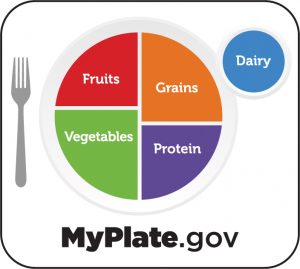Dietary Pattern
Persons with Disabilities Should Consume a Dietary Pattern that Promotes Health and Weight Management and Lowers Risk for Common Chronic Diseases and Conditions
2.1 The United States Department of Agriculture (USDA)’s MyPlate is a nutrition guide that includes a graphic on how we should divide our plate by the five food groups. The recommendations are based on the Dietary Guidelines for Americans. Below are links to resources and information regarding MyPlate.
The USDA MyPlate Tool includes a web-based tool to customize individual meals based on a series of questions.

MyPlate – Veteran’s Health Administration:
USDA – Start simple with MyPlate:
Healthy MyPlate Dietary Guidelines:
USDA Dietary Guidelines for Americans 2020-2025
2.2 Practice the 4 principles of healthy eating, these four principles include (Get FIT):
- Balance – Vegetables, Fruits, Grains, Dairy, and Meat (Protein).
- Moderation – The body can only use certain amounts of each nutrient.
- Variety – Helps to reduce the risk of lifestyle-related illness.
- Adequacy – Quality choices that meet your nutritional needs.
2.3 Consume a variety of fruits and vegetables:
- Examples of fruits include: Apples, bananas, strawberries, grapes, mangos, oranges, papaya, pear, pineapple, watermelon, cantaloupe, fig, grapefruit, kiwi, and many others!
- Examples of vegetables include: Zucchini, eggplant, carrots, romaine lettuce, kale, arugula mixed greens, artichoke, spinach, potato, cabbage, celery, asparagus, broccoli, cauliflower, bell peppers, red onion, cilantro, tomato, parsley, basil, scallions, and many others!
2.4 Limit foods and beverages high in added sugar, saturated fats, and sodium:
- Like chips, crackers, cookies, cakes, and candy.
2.5 Increase nutrient density and proper serving amount:
- Whole foods provide the most amount of nutrients needed for our body and mind.
- The USDA Dietary Guidelines describes “nutrient-dense foods and beverages provide vitamins, minerals, and other health-promoting components and have little added sugars, saturated fat, and sodium. Vegetables, fruits, whole grains, seafood, eggs, beans, peas, and lentils, unsalted nuts and seeds, fat-free and low-fat dairy products, and lean meats and poultry—when prepared with no or little added sugars, saturated fat, and sodium— are nutrient-dense foods.” Dietary Guidelines
2.6 Choose lean animal proteins and proteins from plants, which include poultry, lean meats, and eggs, seafood, beans, peas, lentils, nuts, seeds, and soy products.

